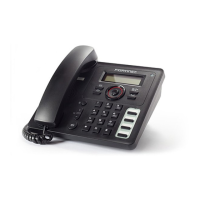Using Web Manager for Configuration Page 33 FortiFone™ User Guide for FON-260i
Line Based Parameters
• Proxy Address: The IP address or FQDN of the phone system, SIP server or SIP proxy.
• Proxy Port: The server port for incoming SIP requests and outgoing responses.
• Display Name: The name used for outgoing Caller ID. The display name assigned for Line 1
also displays on the LCD display when idle.
• Name: The name (phone number) used during registration. The name is generally the
telephone number or the SIP user ID assigned by the administrator or service provider.
• Authentication Name: The user ID for authentication of the line with the phone system or SIP
server/service.
• Authentication Password: The password for authentication of the line with the phone system
or SIP server/service.
• Delayed Ring: Delays the audible notification (ring) for a line. The delay is set in 1-second
increments from 0 (no delay) to 10 seconds.
• Registration Status: Shows the registration status of the phone. Refresh the page if it doesn’t
match the status indicated on the phone.
General Parameters
• Outbound Proxy Address: The IP address or FQDN of the outbound proxy server to receive
SIP requests in place of the line-based Proxy Server.
• Outbound Proxy Port: The port of the outbound proxy server.
• Backup Proxy Address: The IP address or FQDN of the backup proxy server, used when the
connection with the primary proxy times-out.
• Backup Proxy Port: The port of the backup proxy server.
• Domain: The domain for SIP service when the service provider desires to use a specific SIP
domain.
• VMS Address: The address (IP or phone number) of the Voice Mail Server.
• Proxy Registration: Enables SIP registration to the proxy. This parameter is ignored if an
Outbound Proxy Address is not defined.
• Registration Timer: Sets the interval (in seconds) between SIP registration renewal attempts.
• Local UDP Port: The UDP port used on the LAN for sending and receiving SIP packets.
• Local TCP Port: The TCP port used on the LAN for sending and receiving SIP packets.
• Local TLS Port: The TLS port used on the LAN for sending and receiving SIP packets.
• TCP Port: The TCP port used on the LAN for sending and receiving SIP packets.
• TLS Port: The TLS port used on the LAN for sending and receiving SIP packets.
• Transport Mode: The packet transport mode for voice traffic. UDP is most widely used by
most services. FortiVoice phone systems use UDP.
• Start RTP Port: The starting port for used for Real-time Transport Protocol (voice) packets.
• SRTP: Enable if required by the system or service provider.
• Codec Priority: Select the priority for audio codecs.
• Centralized Conference: This parameter enables or disables server control and processing of
conferences. When enabled, the server provides a single RTP stream for the conference.
When disabled, the phone processes separate RTP streams for each participant, maximum
3-parties. A URL is required for centralized conference. FortiVoice does not use centralized
conference.
• Options Timer: This timer sets the SIP options interval.
• STUN Server Address: If required, enter a STUN server IP address or FQDN.

